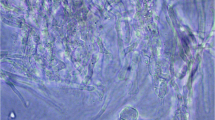Abstract
Further and more conclusive investigations on the life-cycle ofCandida albicans by means of DNA analyses and micromanipulation are reported.
Six main stages are recognizable in the life-cycle of the species under consideration. The sexually active haplophase consists of small cells which either convert to the diplophase by somatogamous autogamy or mutate to the sexually quiescent haplophase with circa 8 × 10−15 g DNA/cell. The nascent diplophase may develop further by budding, convert into chlamydospores or give rise to asexual endospores by internal budding. After a period of dormancy, the budding, uninucleate diplophase with circa 19 × 10−15 g DNA/cell converts when transferred toFowell's acetate agar either into uninucleate chlamydospores or, after becoming multinucleate, into gonotoconts on which the haplophase is delimited externally as buds or as conidia delimited on short sterigmata. By the cultivation of single isolated conidia it was possible to confirm that they were haploid and that heterothallism was absent. The characteristic chalmydospores formed by cultures on corn meal agar were observed to germinate on non-nutritive, 2% washed agar media. Germination occurred by bud formation which gave rise to the haplophase without the formation of a septate promycelium. Since these chlamydospores appear to function as gonotoconts, they are considered to be homologous with the teliospores of theUstilaginales.
This species, together with two others also described, are consequently assigned to the redefined genusSyringospora Quinquad which is provisionally assigned to the tulasnelloid fungi.
Similar content being viewed by others
References
Ainsworth, G. C. (1961) Ainsworth & Bisby's Dictionary of the Fungi. 5th Ed. Kew, Surrey.
Bak, A. L. &Stenderup, A. (1969) Deoxyribonucleic acid homology among perfect and imperfect yeasts.Ant. Leeuwenh. 35 Supplement: Yeast Symposium A 13.
Connants, N. F. Martin, D. S., Smith, D. T., Baker, R. D. &Callaway, J. L. (1944) Manual of Clinical Mycology, Saunders, Philadelphia.
Diddens, H. A. &Lodder, J. (1942) Die anaskosporogene HefenII Hälfte, North Holland Publishing Co., Amsterdam.
Dodge, C. W. (1935) Medical Mycology, Kimpton, St. Louis.
Donk, M. A. (1956) Notes on resuspinate Hymenomycetes. II. The tulasnelloid fungi.Reinwardtia 3:363–379.
Jones, C. P. &Martin, D. S. (1938) Identification of yeast-like organisms isolated from the vaginal tracts of pregnant and non-pregnant womem.Am. J. Obstet. Gynecol. 35:98–106.
Lodder, J. &Kreger-van Rij, N. J. W. (1952). The Yeasts, North Holland Publishing Co. Amsterdam.
Martin, D. S. Jones, C. P. Yao, K. F. &Lee, L. E. (1937) A practical classification of the Monilias.J. Bacteriol. 34:99–123.
Nakase, T. &Komagata, K (1968) Taxonomic significance of base composition of yeast DNA.J. Gen. Appl. Microbiol. 14:345–357.
Okabe, Y. (1929) Studien über den Soorpilz. I. Mitteilung: Bakteriologische Eigenschaften und Systematische Stellung des Soorpilzes.Centr. Bakteriol. Parasitenk. IAbt. Orig. 111:181–194.
Quinquad, M. (1868) Nouvelles recherches sur le muguet.Arch. physiol. 1:290–305.
Robin, CH. (1853) Histoire naturelle des végétaux parasites qui croissent sur l' homme et sur les animaux vivants, Paris.
Sarachek, A. (1964) Pseudoprotrophs and the absence of genetic interactions between auxotrophic strains ofCandida albicans.Microbiol. Genet. Bull. 20:15–17.
Stenderup, A. &Bak, A. L. (1968) Deoxyribonucleic acid base composition of some species within the genusCandida.J. Gen. Microbiol. 52:231–236.
Storck, R. (1966) Nucleotide composition of nucleic acids of fungi II. Deoxyribonucleic acids.J. Bacteriol. 91:227–230.
Talbot, P. H. B. (1954) Micromorphology of the lower Hymenomycetes.Bothalia 6:249–299.
Talbot, P. H. B. (1968) Fossilized pre-Patouillardian Taxonomy.Taxon 17:620–628.
Van der Walt, J. P. (1967) Sexually active strains ofCandida albicans andCryptococcus albidus.Ant. Leeuwenh. 33:246–256.
Van der Walt, J. P. &Pitout, M. J. (1969) Ploidy differences inSporobolomyces salmonicolor andCandida albicans.Ant. Leeuwenh. 35:227–231.
Vuillemin, P. (1898) Les caractères spécifiques du muguet (Endomyces albicans).Acad. Sci. 127:630–633.
Vuillemin, P. (1899) Les formes du champignon du muguet.Rev. mycol. 21:43–55.
Winge, Ö. (1935) On haplophase and diplophase of someSaccharomycetes.Compt. rend. trav. lab. Carlsberg Sér. Physiol. 21:77–108.
Winge, Ö. &Laustsen, O. (1937) On two types of spore germination and on genetic segregations inSaccharomyces demonstrated through single-spore cultures.Compt. rend. trav. lab. Carlsberg Sér. Physiol. 22:99–116.
Wickerham, L. J. &Burton, K. A. (1954) A clarification of the relationship ofCandida guilliermondii to other yeasts by a study of their mating types.J. Bacteriol. 68:594–597.
Author information
Authors and Affiliations
Rights and permissions
About this article
Cite this article
van der Walt, J.P. The genus Syringospora Quinquad emend. Mycopathologia et Mycologia Applicata 40, 231–243 (1970). https://doi.org/10.1007/BF02051777
Accepted:
Issue Date:
DOI: https://doi.org/10.1007/BF02051777




